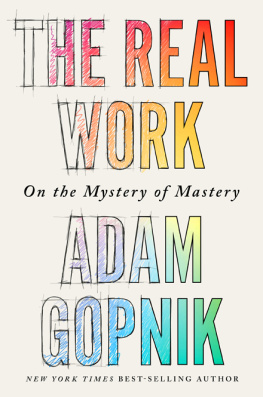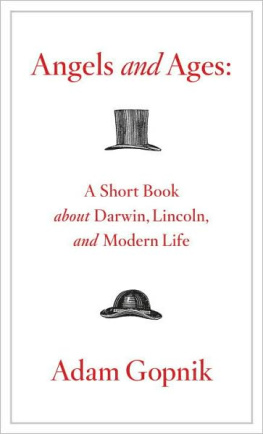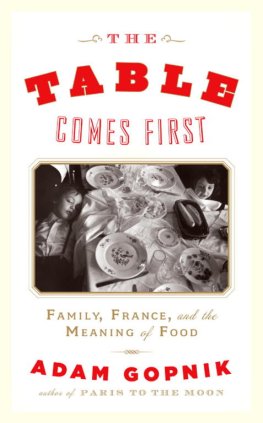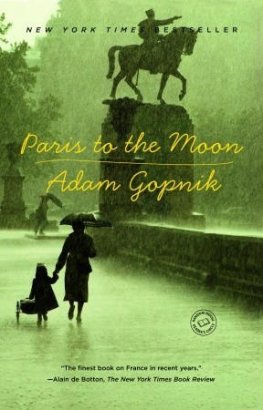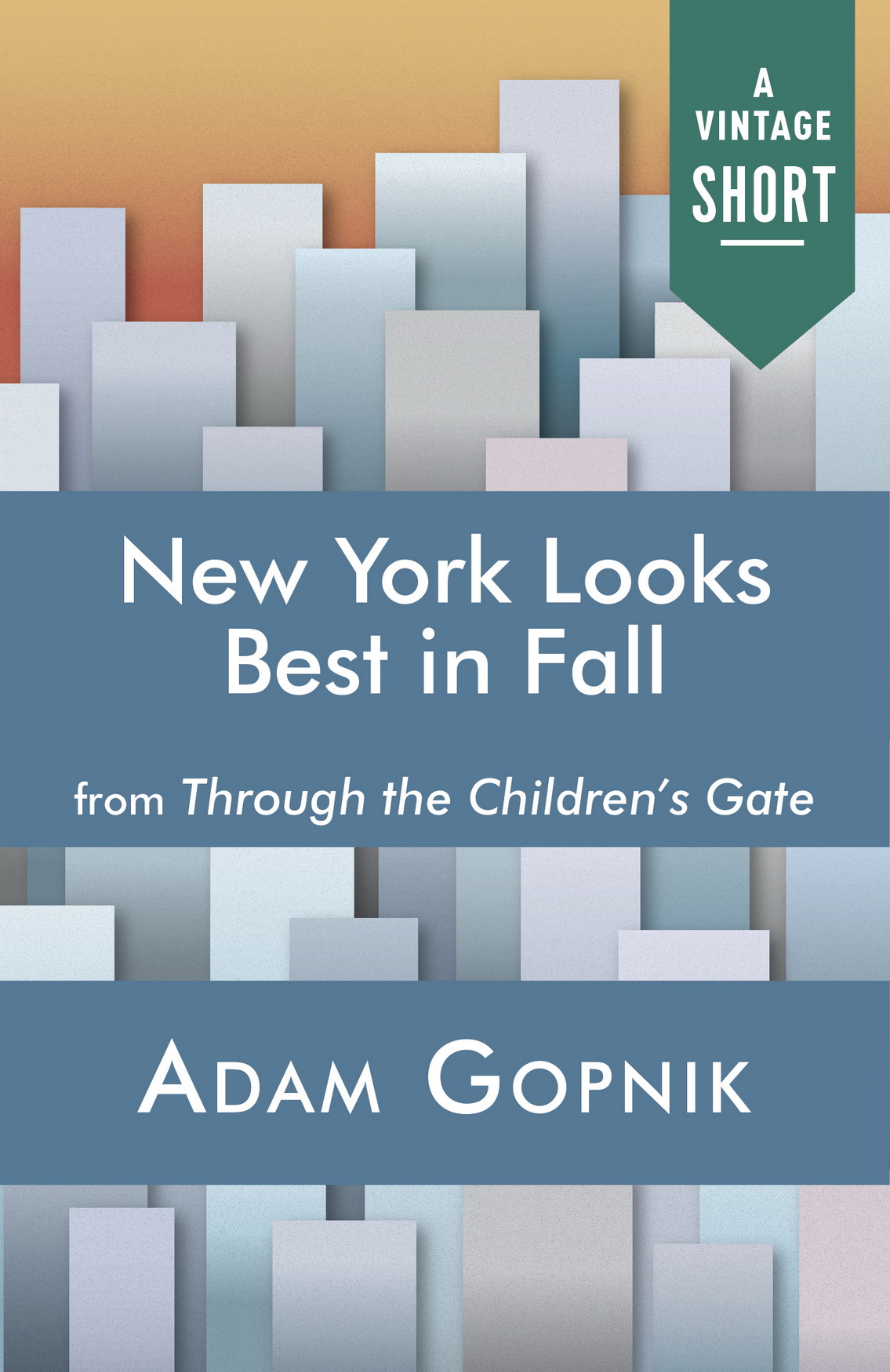Contents
Adam Gopnik
Author of the beloved bestseller Paris to the Moon, Adam Gopnik has been writing for The New Yorker since 1986. He is a three-time winner of the National Magazine Award for Essays and for Reviews and Criticism and of the George Polk Award for Magazine Reporting. He lives in New York City with his wife and their two children.
www.adamgopnik.com
A LSO BY A DAM G OPNIK
The Table Comes First
The Steps Across the Water
Angels and Ages: A Short Book About Darwin, Lincoln, and Modern Life
Through the Childrens Gate
Paris to the Moon
The King in the Window
Americans in Paris: A Literary Anthology (editor)
High and Low: Modern Art and Popular Culture (with Kirk Varnedoe)
New York Looks Best in Fall
from Through the Childrens Gate
Adam Gopnik
A Vintage Short
Vintage Books
A Division of Penguin Random House LLC
New York
Copyright 2006 by Adam Gopnik
All rights reserved. Published in the United States by Vintage Books, a division of Penguin Random House LLC, New York, and in Canada by Random House of Canada, a division of Penguin Random House Ltd., Toronto. Originally published in hardcover as a part of Through the Childrens Gate by Alfred A. Knopf, a division of Penguin Random House LLC, New York, in 2006.
Vintage and colophon are registered trademarks of Penguin Random House LLC.
Portions previously appeared in different form in The New Yorker.
The Cataloging-in-Publication Data for Through the Childrens Gate is available from the Library of Congress.
Vintage eShort ISBN9781101972564
Cover design by Perry Delavega
www.vintagebooks.com
v4.1
a
Contents
N ew York still looks best in fall. (April in Paris is a fiction, but Autumn in New York, by the same songwriter, is a glorious fact.) Thanksgivingnot just the holiday, I mean, but the sweep of days it superintends, the long autumn that begins in October and runs, festively, through the Jewish holidays, to Halloween and beyond, with Christmas peeking around the cornerhas always been the best time of year in New York. Abroad, I often thought about the lines at Ottomanellis in the Village the day before Thanksgiving, where everybody who ordered a turkey has his name misspelled in black marker on brown paperand I thought about the absence of evident warmth combined with the come-one-come-all brown-paper democracy of the scene, the weary procedural dutifulness of the butchersand I then felt a rush of something like patriotism. These months are nearly perfect in New York, the slow roll up to the great secular feast of shopping and feeling at Christmas. After that comes dread, the winter with shoes in the trees and unbiodegradable plastic bags blowing at your feet, the Lenny-Bruce-in-Times-Square sordidness of the place.
To inventory the holidays, Jewish and Christian and creedless, each with its little burst of merchandise and ritual, is to expose the intermingling of the sacred and the secular. But that is our city, and it fits somehow. In London, where they invented the idea of Christmas as middle-class mass ritual, there is still some sense that the festival overflows from the spiritual side; Dickens makes his dutiful, sober asides to the religious holiday before he gets on with the games. In Paris, the old Catholic hardness one hears in French baroque Christmas music, the premonition of tragedy that is so much a part of Christmas for the believer, still reigns. But in New York, heroic materialism is all the heroism weve got, and it goes on: Thanksgiving, secular and greedy, balloons pumped up with helium, leading to the coronation of the department-store Santa Claus.
The first few weeks back from France are precious, because naive vision is a capital sum, quickly depleted, and for a few months, New Yorkthe Great Home, Our Placecan be seen again. On our first morning back, woken early by the jet lag, I took Luke for a long dawn walk down Fifth Avenue, past the University Club and St. Patricks Cathedral and Saks. This is all from another place, I thought, shocked by the derivativeness of Fifth Avenue architecture. I felt, I saw, for the first time ever, the adolescent absurdity of so many Manhattan monumentsthe sad, wilderness, opera-house-in-the-Arctic and Amazon pathos of copying old European styles in a New World city. This isnt a true Gothic cathedral, I thought, staring at St. Patricks. There are such things, Ive seen them, and this is just acopy, a raw inflated thing thrown up in emulation of a far-off and distant thing! That Renaissance palazzo on Fifty-fourth Street is no Renaissance palazzoits a cheap stage-set imitation!
This perceptionof New York as a blown-up Inflato city, aspirational rather than achieved, gawkily imitating its models, the proper cities of Europewhich was once so obvious and embarrassing (to Henry James, much less to Tocqueville), has faded away now, and I no longer see it that way. For that single early morning, though, it seemed that the architecture of New York was not quite real, not organic, coming from elsewhere and imposed, a delirium of old styles and other peoples European visions: the Gothic vision of sublime verticality, or, for that matter, the Bauhaus vision of the glass tower. For a moment New York seemed unnatural, the anti-matter city. Youre not real! I wanted to cry out, to the city. Yes, we are, the buildings cried back blankly. It is the old thing that is the lie; the true thing is our re-creation of it. But the moment passed quickly, and now New York just looks like New York: old as time, worn as Rome, mysterious as life.
T he children are flying above our heads, the neighbors are sighing below our feet, and between them we are trying to return to a life we thought we knew already. A full life is what we said we wanted when we left Paris, and full it is, in moments already too full. We fill our eyes and heads with things already seen and known, and try to see them and know them again.
The city looks wonderful no matter how you squint at it, theres no denying that: the park restored, the shops freed from their goalie masks of protective cages, even Times Square, through which I had to trudge by night twenty years ago to extract Martha from seedy out-of-the-way film-cutting rooms. Where we once threaded our way among Dumpsters in which bodies turned up is now gleaming, but the cutting rooms have become condos, and the film editors have fled to some other place, as yet unknown.
The children are even happier to be here than Id hoped. On that first morning, once the stores were open (the coffee shops, I had forgotten, never close), I bought Luke the one thing he wanted: a Razor-brand scooter, the kind that was invented while we were away and that now fills the streets here. (They have not yet made it to Paris.) They are one of those simple, amazing things that make you wonder enviously why no onewhy not you!had thought of it before: three pieces of hinged aluminum, a pair of plastic wheels, and youre whooshing off down the avenue to the delight of other children and to the doom of the calves of a thousand old ladies on Madison.
As he rushes down the streets, Lukes ears are still attuned to the new sounds of the city. I see him stop his scooter and leap from it in ecstasy: Those girls are speaking English, he informs me. I think Ill talk to them. This delivery to his long-dreamed-of paradise, the English-speaking city, is still beyond his comprehension. The density of space produces, famously, a wild variety of people. Luke, hostage to Parisian food, cannot believe the range of cheap takeout, the empire of menus. You press a button, and all the worlds spices come obsequiously to your door: Indian food, Chinese food; the baby loves chicken in pancakes, the boy loves steak fajitas, and without saying so, I see that he likes the sweetness of New York food, the way that, as I had forgotten, Americans put sugar in everything, in ketchup and mustard and cereal and bread. The incidental sweetness of American life is, to an unaccustomed palate like his, overwhelming and quickly addictive.


